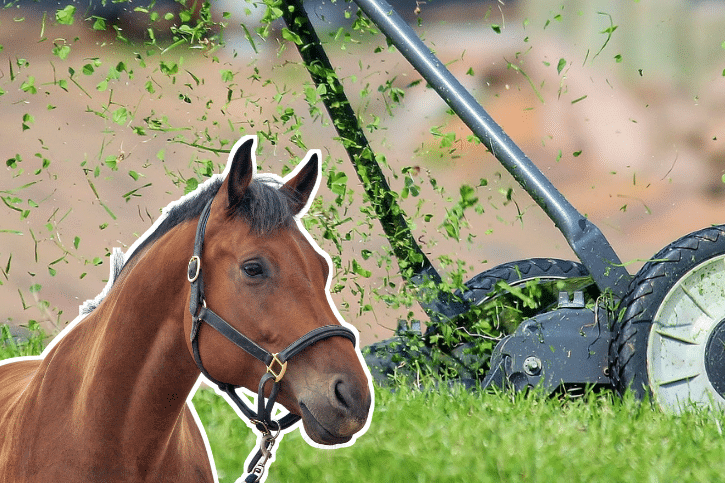Can Horses Eat Fresh Cut Grass?
I was talking with my friend who owns horses the other day about how big her property is.
She has several acres and her horses are free to roam every day out in the pasture.
I marveled at how it seemed her grass was always cut, and I asked her if her horses kept the grass height down for her or if she had to cut the grass herself.
She told me it all depended on whether the horses were able to keep the grass cut down to 3-4 inches or not.
If not, then she would mow the grass.
Confused, I asked what she did with the grass after she cut it if the horses needed the grass for food.
Can horses eat fresh-cut grass?
The answer is yes, horses can eat fresh-cut grass though it’s not as simple as just putting out a pile of grass. Many factors need to be considered to ensure the grass cuttings do not put the life or health of your horse at risk.
Horses are natural grazers, and they eat grass all day, every day.
Your horse rips the grass with its teeth and chews it, which keeps the grass’s height down.
What are the dangers of feeding fresh-cut grass?
When your horse is grazing and eating grass, it has to rip apart the blades of grass and chew them to get anything to eat.
When you provide grass to your horse, there are several potential dangers that you may not have thought of.
Grass clumps
When grass is cut, moisture is released from the grass, combined with any water already present on the ground, and produces clumps of grass.
Horses that eat live grass from the ground never eat chunks, but horses that eat fresh-cut grass may ingest a tuft.
Fresh-cut grass is easier to get in the mouth, and your horse runs a risk of ingesting a clump that lodges in its throat, causing choking.
If this happens to your horse, do not attempt to dislodge the clump.
Call your veterinarian right away.
Cut grass holds moisture
Moisture cannot escape from grass clumps.
When water is contained within the grass, it promotes the growth of mold and bacteria.
Ingesting moldy or fermented grass can be deadly for your horse.
Eating grass too fast can cause colic and laminitis
Horses have a delicate digestive system, and overeating too fast can easily lead to colic.
Natural grazing habits lead to slow eating, but eating cut grass eliminates the steps that lead to slow eating.
Colic is abdominal pain and gas that horses experience when undigested starch ferments in the colon.
This fermentation process changes the pH in the horse’s gut and leads to excess production of gas.
In addition to having abdominal pain due to the excess gas, prolonged changes in pH can lead to a condition called laminitis.
Laminitis is a painful inflammatory response that occurs in the soft tissue of the pedal bone.
If left untreated, it can lead to permanent changes to the bone structure in a horse’s hoofs or, worse, death.
Why is hay okay for horses to eat?
The process by which hay is made ensures the above dangers are not a risk to your horse.
Hay is grass, it’s true.
But it’s much more than just grass.
Hay is a grass that is properly cut and dried before being baled or rolled.
Care is taken to avoid cutting into the soil, which could expose the horse to dangerous bacteria.
The manufacturers of hay keep the grass dry throughout the process to prevent mold growth.
How do I keep my horse from eating cut grass?
When you have to cut your grass, you may wonder how to keep your horse from eating the cuttings?
There are a few options depending on your situation.
You can place a horse in a paddock until the grass dries.
A paddock is a small fenced area with several uses, one of which is to prevent them from eating wet grass cuttings.
Paddocks are a great option and the safest.
If you don’t have a paddock, you can have your horse wear a grazing muzzle.
This will make it more difficult for them to get into the grass cuttings or consume a lot of grass in a short amount of time.
Though not foolproof, you can rake out the remaining grass cuttings.
Spreading them out will promote faster drying.
If you can have someone collect the cuttings and remove them from the pasture, this could allow your horses to get back to their grazing as fast as possible.
How long does it take for grass cuttings to dry?
You may want to know when it will be safe to return your horse to its pasture.
This timeframe will vary based on a few factors.
If you can spread the remaining grass cuttings widely, the sun should be able to dry them within a day or two.
If it’s humid, overcast, or very dewy, then it may take several days. If you live in a very humid environment, it may be best to have the cuttings removed.
You can help the cuttings to dry faster by only cutting your grass when it’s very dry.
Avoid cutting the grass in the morning while there is still dew on the ground.
Avoid cutting the grass after rain or when it’s overcast or foggy.
Cutting the grass when it’s dry results in a more precise and even cut and is less likely to clog the mower.
Veterinarians encounter digestive diseases that can be prevented every day.
The best grass for horses is live grass that they graze on slowly.
If this is not possible, then hay is the next best option.
Purposely feeding fresh-cut grass is not advisable.
If your horse ingests some grass cuttings while grazing, pay close attention to signs of illness and always contact your veterinarian sooner than later.
